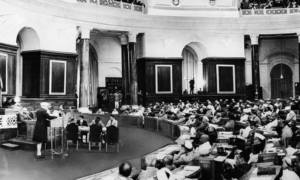The processes of framing the Constitution of India started with the formation of the Constituent Assembly in 1946 before independence and lasted till November 26, 1949, when the Constitution of India came into force.

Pt. Jawaharlal Nehru giving speech in Constituent Assembly | Credit: Journal of Indian Law and Society
The Constituent Assembly was elected by the members of the Provincial Assemblies in 1946 and had 389 members. It was later reduced to 299 after the partition of India. The Constituent Assembly was chaired by Dr. Rajendra Prasad, and Dr. B.R. Ambedkar was the chairman of the Drafting Committee.
In the first session of the Constituent Assembly, on 13 December 1946, the adoption of the Objectives Resolution was moved by Jawaharlal Nehru. The Objectives Resolution declared India as an independent sovereign republic and laid down the general principles and goals of the Constitution. It was adopted by the Constituent Assembly on 22nd January 1947.
Then a number of committees were established to examine and report on different aspects of the Constitution. These included the Advisory Committee on Fundamental Rights, Minorities, and Tribal and Excluded Areas; the Union Powers Committee; the Union Constitution Committee; and the Provincial Constitution Committee.
This was followed by the scrutiny of the Draft Constitution prepared by B.N. Rau, the Constitutional Adviser to the Constituent Assembly, based on the reports of various committees and discussions in the Constituent Assembly. The Drafting Committee, headed by Dr. B.R. Ambedkar, revised and modified the Draft Constitution and submitted it to the Constituent Assembly in February 1948. The draft was published for public review. The comments received were then scrutinised by a Special Committee comprising members of the Union Constitution Committee, Provincial Constitution Committee, Union Powers Committee, and Drafting Committee. The Drafting Committee then resubmitted the First Draft submitted previously along with a list of amendments it intended to make.
The members of the Constituent Assembly were then invited to review the revised Draft Constitution for a second reading during which extensive debates took place. During the debates, a number of amendments were proposed, of which the majority were rejected. The Drafting Committee then revised the Draft Constitution in accordance with the suggestions of the Constituent Assembly and submitted it for a third reading.
The third reading came to an end on 26th November 1949 with the voting of the Constituent Assembly in favour of the motion proposed by Dr. B.R. Ambedkar. The final version of the Constitution was signed by members of the Assembly on 24 January 1950, and it came into effect on 26 January 1950.
Continue to the next section: Constitutional Assembly Debates
